Alu 301 chapter 4 - Study guides, Class notes & Summaries
Looking for the best study guides, study notes and summaries about Alu 301 chapter 4? On this page you'll find 57 study documents about Alu 301 chapter 4.
Page 2 out of 57 results
Sort by
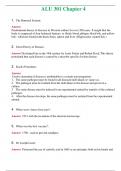
-
ALU 301 Chapter 4 (Latest 2024) Questions With Complete Grade A+ Answers
- Exam (elaborations) • 15 pages • 2024
- Available in package deal
-
- $10.99
- + learn more
ALU 301 Chapter 4 (Latest 2024) Questions With Complete Grade A+ Answers
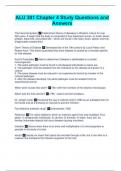
-
ALU 301 Chapter 4 Study Questions and Answers
- Exam (elaborations) • 8 pages • 2024
-
Available in package deal
-
- $10.49
- + learn more
The Humoral System Predominant theory of disesase in Western culture for over 200 years. It taught that the body is composed of four balanced humors, or fluids: blood, phlegm, black bile, and yellow bile - which are found in the heart, brain, spleen and liver. (Hippocrates created this.) Germ Theory of Disease Developed late in the 19th century by Louis Pateur and Robert Koch. This theory postulated that each disease is caused by a microbe specific for that disease. Koch's Postulates Used...
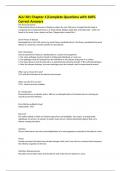
-
ALU 301 Chapter 4|Complete Questions with 100% Correct Answers
- Exam (elaborations) • 9 pages • 2024
-
- $11.50
- + learn more
ALU 301 Chapter 4|Complete Questions with 100% Correct Answers The Humoral System Predominant theory of disesase in Western culture for over 200 years. It taught that the body is composed of four balanced humors, or fluids: blood, phlegm, black bile, and yellow bile - which are found in the heart, brain, spleen and liver. (Hippocrates created this.) Germ Theory of Disease Developed late in the 19th century by Louis Pateur and Robert Koch. This theory postulated that each disease is cause...

-
ALU 301 Chapter 4|Complete Questions with 100% Correct Answers
- Exam (elaborations) • 9 pages • 2024
-
- $9.99
- + learn more
ALU 301 Chapter 4|Complete Questions with 100% Correct Answers The Humoral System Predominant theory of disesase in Western culture for over 200 years. It taught that the body is composed of four balanced humors, or fluids: blood, phlegm, black bile, and yellow bile - which are found in the heart, brain, spleen and liver. (Hippocrates created this.) Germ Theory of Disease Developed late in the 19th century by Louis Pateur and Robert Koch. This theory postulated that each disease is cause...
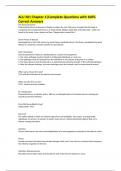
-
ALU 301 Chapter 4|Complete Questions with 100% Correct Answers
- Exam (elaborations) • 9 pages • 2024
-
Available in package deal
-
- $11.50
- + learn more
ALU 301 Chapter 4|Complete Questions with 100% Correct Answers The Humoral System Predominant theory of disesase in Western culture for over 200 years. It taught that the body is composed of four balanced humors, or fluids: blood, phlegm, black bile, and yellow bile - which are found in the heart, brain, spleen and liver. (Hippocrates created this.) Germ Theory of Disease Developed late in the 19th century by Louis Pateur and Robert Koch. This theory postulated that each disease is cause...
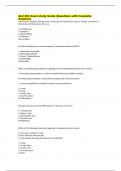
-
ALU 301 Complete Exam Bundle Graded A+!!!
- Package deal • 12 items • 2024
-
- $33.49
- + learn more
ALU 301 Exam Practice Questions With Correct Answers. 2 Exam (elaborations) ALU 301 Exam study Guide |Questions with Complete Solutions 3 Exam (elaborations) ALU 301 Exam study Guide |Questions with Complete Solutions Graded A+ 4 Exam (elaborations) ALU 301 Chapter 1 Complete Questions with 100% Correct Answers Graded A+ 5 Exam (elaborations) A
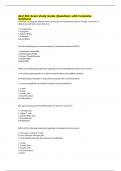
-
ALU 301 Complete Exam Bundle Graded A+!!!Latest Update
- Package deal • 12 items • 2024
-
- $34.49
- + learn more
Exam (elaborations) ALU 301 Exam Practice Questions With Correct Answers. 2 Exam (elaborations) ALU 301 Exam study Guide |Questions with Complete Solutions 3 Exam (elaborations) ALU 301 Exam study Guide |Questions with Complete Solutions 4 Exam (elaborations) ALU 301 Chapter 1 Complete Questions with 100% Correct Answers 5 Exam (elaborations)
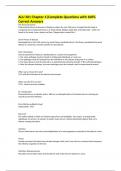
-
ALU 301 Chapter 4|Complete Questions with 100% Correct Answers
- Exam (elaborations) • 9 pages • 2024
-
Available in package deal
-
- $11.49
- + learn more
ALU 301 Chapter 4|Complete Questions with 100% Correct Answers The Humoral System Predominant theory of disesase in Western culture for over 200 years. It taught that the body is composed of four balanced humors, or fluids: blood, phlegm, black bile, and yellow bile - which are found in the heart, brain, spleen and liver. (Hippocrates created this.) Germ Theory of Disease Developed late in the 19th century by Louis Pateur and Robert Koch. This theory postulated that each disease is cause...
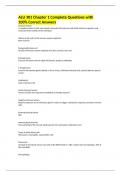
-
ALU 301 Complete Exam Bundle Graded A+!!!
- Package deal • 11 items • 2024
-
- $32.49
- + learn more
1 Exam (elaborations) ALU 301 Exam Practice Questions With Correct Answers. 2 Exam (elaborations) ALU 301 Exam study Guide |Questions with Complete Solutions 3 Exam (elaborations) ALU 301 Exam study Guide |Questions with Complete Solutions 4 Exam (elaborations) ALU 301 Chapter 1 Complete Questions with 100% Correct Answers 5 Exam (elaborations)
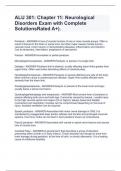
-
ALU 301: Chapter 11: Neurological Disorders Exam with Complete SolutionsRated A+).
- Exam (elaborations) • 10 pages • 2024
-
Available in package deal
-
- $11.49
- + learn more
ALU 301: Chapter 11: Neurological Disorders Exam with Complete SolutionsRated A+). ++ivity, but individuals with CP often have associated musculoskeletal problems, learning disabilities, behavioral problems, some paralysis, some intellectual function deficits, sensorineural loss visual and auditory and seizures. Subgroups of cerebral palsy - ANSWER-1. Dyskinesia syndromes 2. Spastic cerebral palsy 3. Ataxic Dyskinesia syndromes - ANSWER-Often associated with the hemiplegic or diplegic f...

$6.50 for your textbook summary multiplied by 100 fellow students... Do the math: that's a lot of money! Don't be a thief of your own wallet and start uploading yours now. Discover all about earning on Stuvia


